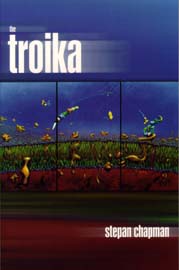The Troika
Stepan Chapman
Ministry of Whimsy Press
US Trade Paperback
ISBN 1-89064-02-3
256 pages; $14.99
Reviewed by Rick Kleffel © 2001

REFERENCES
COLUMNS
|
|
|
The TroikaStepan ChapmanMinistry of Whimsy PressUS Trade PaperbackISBN 1-89064-02-3256 pages; $14.99Reviewed by Rick Kleffel © 2001 |
|
|
REFERENCES |
COLUMNS |
Horrific science fiction is often all too predictable; you get a scientist, a monster, a soldier, a love interest, a few chase scenes and The Final Confrontation. Simple, easy-to-glom-onto characters are introduced in sequence, brought together, and some are eliminated as the conflicts are resolved. End-of-story. Fortunately, that formula doesn't even get you to the beginning of Stepan Chapman's 'The Troika', a return to the grand tradition of ultra-weird, in-your-face, what-the-hell-is-going-on? science fiction. As the novel beings, we meet a jeep, a dinosaur, and an old Mexican woman. They are traveling across the desert. They have been doing so for eternity. And then things get strange.
'The Troika' is a part of that sub-genre of science fiction written in the form of a mystery where the primary question is how our world was transformed into or is connected to the world of the story. Chapman writes in an almost ecstatic, illuminated prose, creating isolated yet inter-connected imaginary landscapes that are startling, bizarre and graphically horrific. To his credit, however, Chapman does establish that connection by the end of the novel. From a world of maritime mutants, to a laundromat transformation, Chapman's imagination burns bright. More importantly, he manages to hallucinate on the pages but keep the plot moving quickly enough to make sure those pages turn at a brisk pace.
Chapman's concerns echo those of Philip K. Dick and Stanislaw Lem. He writes about the reality of imagination, and manipulates the realities of the characters and what they imagine to be real. In the process, he evokes fear, terror, tedium and wonder in rapid succession, then makes you care about a jeep.
The packaging by Ministry of Whimsy Press is beautiful. The cover painting is a nicely printed Dali-esque cellscape that sets the tone for the novel. The interior drawings are simple but add class to the package. There is no doubt that this is fiction on the edge, and as such, it may actually frighten some readers away. The novel encourages such readers to remain at a distance. But those readers brave enough to make the journey will not forget Chapman's unique creations.